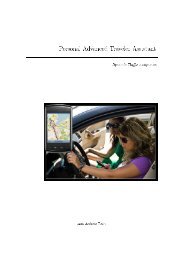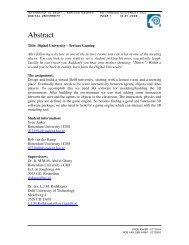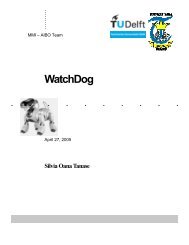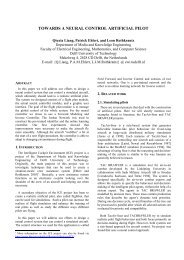Recognition of facial expressions - Knowledge Based Systems ...
Recognition of facial expressions - Knowledge Based Systems ...
Recognition of facial expressions - Knowledge Based Systems ...
Create successful ePaper yourself
Turn your PDF publications into a flip-book with our unique Google optimized e-Paper software.
detailed in table 4. The dependency <strong>of</strong> the<br />
parameters on AUs was determined on the<br />
criteria <strong>of</strong> influence observed on the initial<br />
database. The presence <strong>of</strong> one AU at this stage<br />
does not imply the existence <strong>of</strong> one <strong>facial</strong><br />
expression or another.<br />
Instead, the goal <strong>of</strong> the next layer containing the<br />
AU nodes and associated dependencies is to<br />
determine the probability that one AU presents<br />
influence on a given kind <strong>of</strong> emotion. The final<br />
parametric layer consists <strong>of</strong> nodes for every<br />
emotional class. More than that, there is also one<br />
node for the current expression and another one<br />
for that previously detected. The top node in the<br />
network is that <strong>of</strong> current expression. It has two<br />
states according to the presence and absence <strong>of</strong> any<br />
expression and stands for the final result <strong>of</strong><br />
analysis. The absence <strong>of</strong> any expression is seen as a<br />
neutral display <strong>of</strong> the person’s face on the current<br />
frame. While performing recognition, the BBN<br />
probabilities are updated in a bottom-up manner.<br />
As soon as the inference is finished and <strong>expressions</strong><br />
are detected, the system reads the existence<br />
probabilities <strong>of</strong> all the dependent expression nodes.<br />
The most probable expression is that given by the<br />
larger value over the expression probability set.<br />
Table 4. The emotion projections <strong>of</strong> each AU<br />
combination<br />
Figure 5. BBN used for <strong>facial</strong> expression recognition<br />
8 Results<br />
The implementation <strong>of</strong> the model was made<br />
using C/C++ programming language. The system<br />
consists in a set <strong>of</strong> applications that run different<br />
tasks that range from pixel/image oriented<br />
processing to statistics building and inference by<br />
updating the probabilities in the BBN model.<br />
The support for BBN was based on S.M.I.L.E.<br />
(Structural Modeling, Inference, and Learning<br />
Engine), a platform independent library <strong>of</strong> C++<br />
classes for reasoning in probabilistic models [5].<br />
S.M.I.L.E. is freely available to the community<br />
and has been developed at the Decision <strong>Systems</strong><br />
Laboratory, University <strong>of</strong> Pittsburgh. The library<br />
was included in the AIDPT framework. The<br />
implemented probabilistic model is able to<br />
perform recognition on six emotional classes and<br />
the neutral state. By adding new parameters on<br />
the <strong>facial</strong> expression layer, the expression<br />
number on recognition can be easily increased.<br />
Accordingly, new AU dependencies have to be<br />
specified for each <strong>of</strong> the emotional class added.<br />
In figure 7 there is an example <strong>of</strong> an input video<br />
sequence. The recognition result is given in the<br />
graphic containing the information related to the<br />
probability <strong>of</strong> the dominant <strong>facial</strong> expression<br />
(see Figure 6).<br />
9 Conclusion<br />
In the current paper we’ve described the<br />
development steps <strong>of</strong> an automatic system for<br />
<strong>facial</strong> expression recognition in video sequences.<br />
The inference mechanism was based on a<br />
probabilistic framework. We used the Cohn-<br />
131
















